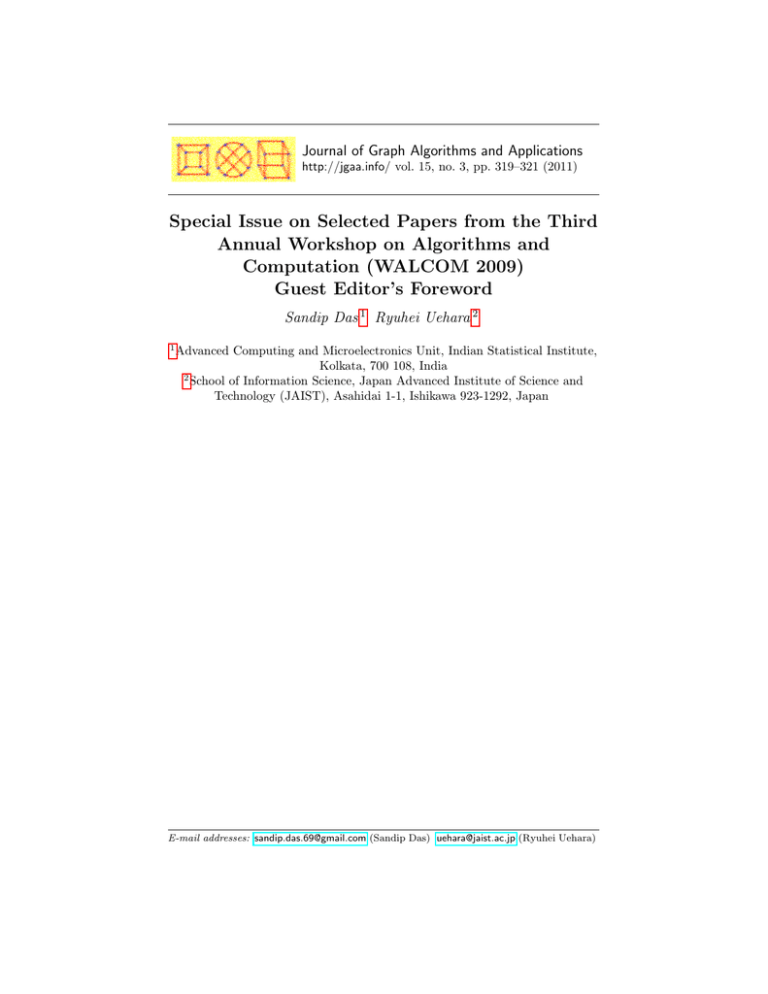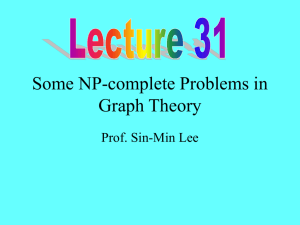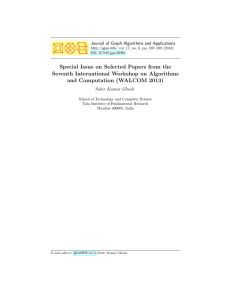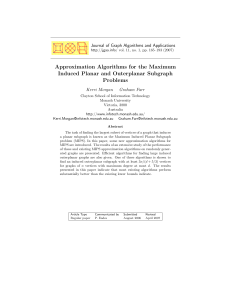Special Issue on Selected Papers from the Third Computation (WALCOM 2009)
advertisement

Journal of Graph Algorithms and Applications http://jgaa.info/ vol. 15, no. 3, pp. 319–321 (2011) Special Issue on Selected Papers from the Third Annual Workshop on Algorithms and Computation (WALCOM 2009) Guest Editor’s Foreword Sandip Das 1 Ryuhei Uehara 2 1 Advanced Computing and Microelectronics Unit, Indian Statistical Institute, Kolkata, 700 108, India 2 School of Information Science, Japan Advanced Institute of Science and Technology (JAIST), Asahidai 1-1, Ishikawa 923-1292, Japan E-mail addresses: sandip.das.69@gmail.com (Sandip Das) uehara@jaist.ac.jp (Ryuhei Uehara) 320 S. Das and R. Uehara WALCOM 2009 Guest Editors’ Foreword This special issue is devoted to the third annual Workshop on Algorithms and Computation (WALCOM 2009), which was held in February 2009 in Indian Statistical Institute, Kolkata, India. We invited several of the highest ranked papers, providing a view of the depth and width of various areas in algorithms and theory of computation. The authors submitted extended versions of their contribution papers of the conference, which were refereed by the reviewers, and then revised afterwards. Both theoretical and practical aspects are covered in this collection. The topics range from (a) characterization of unigraphs, (b) balanced tree partitioning, to more applied topics such as: (c) generation of 5-regular planar graph, and (d) graph drawing related problems. Graphs uniquely determined by their own degree sequences up to isomorphism are termed as unigraphs. A. Borri, T. Calamoneri, and R. Petreschi present characterization of unigraphs, and propose a new liner time recognition algorithm that is essentially different from the previously known linear time algorithm. This characterization generalizes a known characterization for matrogenic graphs that form a subclass of unigraphs. The problem of finding a balanced tree cover of a graph under Euclidean metric plays an essential role for designing an approximation algorithm for min-max subtree cover problem. S. Karakawa, E. Morsy, and H. Nagamochi proposed 1.965-approximation polynomial time algorithm for d-dimensional Euclidean space with d ≥ 3. For d = 2, the approximation ratio is 1.954 which contrasts the best possible bound 2 in general metric. Given a planar embedded acyclic digraph G, the authors T. Mchedlidze and A. Symvonis, study the problem of adding a set of edges to G in order to make it a Hamiltonian acyclic digraph while introducing the smallest possible number of edge crossings for the given embedding. The paper is interesting, since it introduces and studies for the first time the concept of edge crossing minimization in the Hamiltonian completion problem. Results concerning this problem are important in their own. M. Hasheminezhad, B. D. McKay, and T. Reeves propose a set of rules which can generate simple planar 5-regular graphs recursively. They show the same result for simple planar pentagulatons with minimum degree 2. F. Frati proved that an outerplanar graph has a straight-line grid drawing in O(dn log n), where d is the maximum degree. R. Karim, J. Alam and S. Rahman extend Frati’s result to show that under the condition of being “labelconstrained”, the dependence on d can be removed. A linear time algorithm for testing whether an outerplanar graph is “label-constrained” is given. Md. T. Parvez Md. S. Rahman, and S. Nakano address the problem of generating all triangulations of plane graphs. They propose efficient algorithms for generating all triangulations of graphs like a triconnected plane graph, a cycle of n vertices and similar structure. Many thanks go to the authors for contribution of their high-quality papers, to the reviewers for their excellent professional service, and to the Editors of the Journal of Graph Algorithms and Applications for making this special issue possible.






